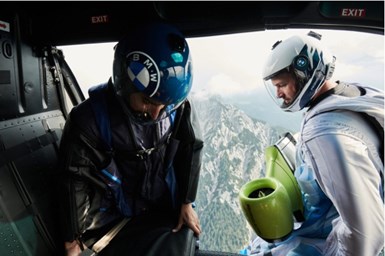BMW i develops first electrified wingsuit for human flight
Embodying a futuristic approach, the carbon fiber and aluminum wingsuit with its electric propulsion system is a concept that even airsports daredevils won’t be able to ignore.

Photo Credit: Globetrender
Note: This article was provided by , and originally reported by Erica Jamieson.
Together with BMW Group company Designworks (Newbury Park, Calif., U.S.) and air sportsman and professional base jumper Peter Salzmann, (a sub-brand of BMW founded in 2011 to design and manufacture plug-in electric vehicles) has developed an electric-powered wingsuit, which has been successfully flown over mountains in Austria. After jumping from a helicopter 3,000 meters up, Salzmann completed what is said to be the world’s first human flight powered by electric wingsuit in Nov. 2020. The wingsuit design even incorporates carbon fiber and aluminum.
The suit, propelled by two 13-centimeter carbon impellers with an overall output of 15 kilowatts (kW), allowed Salzmann to gain altitude and soar above the “Three Brothers” mountain peak in Austria. Mid-flight, the suit reached a top speed of 186 miles per hour. For a sport that typically celebrates top horizontal speeds of about 60 miles per hour, the “electrified wingsuit,” according to BMW i, will create new opportunities in daredevil airsports — and “Pay for Peril” adventure tourism.
“At the time, I was developing suits for skydiving and basejumping with a friend and basejumping mentor,” Salzmann tells . “One of them was a supporting motor — and it’s an idea I just couldn’t shake. I found the idea of being able to jump from my local mountain wearing the wingsuit and land in my garden fascinating.”
Salzmann brought the concept to BMW and, in 2017, they got to work.

Photo Credit: Globetrender
“Our future-oriented approach with electric propulsion systems and innovative materials and technologies were a perfect fit for Peter Salzmann’s unusual but fascinating idea,” says Stefan Ponikva, vice president of brand experience at BMW i. “In my opinion, Peter Salzmann perfectly embodies the attitude of the BMW i brand with his vision, his passion and his courage. I was also impressed by his physical effort, combined with in-depth technical knowledge and a very clear understanding of the brand.”
Resembling “a futuristic mini-submarine,” the final design, in addition to using carbon fiber, also has a thumb and finger-operated throttle on the left sleeve. The electric propulsion system is powered by a 50-volt (V) lithium battery attached to the suit’s chestplate, and can produce thrust for up to 15 minutes. In alignment with the BMW i brand, the automaker’s line of fully electric cars, the wingsuit can be fueled by renewable energy.
“Sustainability is very important to me, and something I try to live my everyday life by. I enjoy nature from the air and on the ground — that’s why I aim to consistently follow the path of sustainability even when it comes to mobility,” Salzmann tells BMW.
The suit was tested in BMW’s horizontal wind tunnel, AEROLAB, and in a vertical wind tunnel in Sweden. An initial design prototype, with 40% additional power output was scrapped in favor of lighter design and improved freedom of movement.
The electric wingsuit was originally slated to debut in South Korea in spring 2020, a plan delayed by the pandemic. The Drei Brüder, or “Three Brothers” peaks in the Hohe Tauern Austrian mountain range, close to Salzmann’s childhood home, were selected as a replacement location.
To prepare for the flight, Salzmann completed specialized training to develop his core, neck and shoulder muscles in order to hold himself in the right position for the duration of the flight. With the first flight under his belt, Salzmann has already set his eyes on new goals — flying between high rise buildings in South Korea.
The maiden voyage has also marked the first edition of BMW’s #NEXTGen 2020 series, showcasing new technologies and vehicles that envision next-generation mobility.
Find the full report by Globetrender .
Related Content
JEC World 2024 highlights: Thermoplastic composites, CMC and novel processes
CW senior technical editor Ginger Gardiner discusses some of the developments and demonstrators shown at the industry’s largest composites exhibition and conference.
Read MorePlant tour: Teijin Carbon America Inc., Greenwood, S.C., U.S.
In 2018, Teijin broke ground on a facility that is reportedly the largest capacity carbon fiber line currently in existence. The line has been fully functional for nearly two years and has plenty of room for expansion.
Read MorePlant tour: Airbus, Illescas, Spain
Airbus’ Illescas facility, featuring highly automated composites processes for the A350 lower wing cover and one-piece Section 19 fuselage barrels, works toward production ramp-ups and next-generation aircraft.
Read MoreInfinite Composites: Type V tanks for space, hydrogen, automotive and more
After a decade of proving its linerless, weight-saving composite tanks with NASA and more than 30 aerospace companies, this CryoSphere pioneer is scaling for growth in commercial space and sustainable transportation on Earth.
Read MoreRead Next
Ceramic matrix composites: Faster, cheaper, higher temperature
New players proliferate, increasing CMC materials and manufacturing capacity, novel processes and automation to meet demand for higher part volumes and performance.
Read MoreUltrasonic welding for in-space manufacturing of CFRTP
Agile Ultrasonics and NASA trial robotic-compatible carbon fiber-reinforced thermoplastic ultrasonic welding technology for space structures.
Read MoreNext-gen fan blades: Hybrid twin RTM, printed sensors, laser shock disassembly
MORPHO project demonstrates blade with 20% faster RTM cure cycle, uses AI-based monitoring for improved maintenance/life cycle management and proves laser shock disassembly for recycling.
Read More












